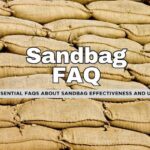Flooding can be a nightmare for businesses, causing costly damage, disrupting operations, and even driving away customers. The good news? Preventing water issues doesn’t have to break the bank. With the right drainage systems, you can protect your property, reduce maintenance costs, and safeguard your business for the long term. Here are 10 cost-effective drainage solutions that every business owner should consider.
1️⃣ Permeable Pavement 🌧️
Permeable pavement is one of the most effective ways to control runoff and prevent water accumulation in high-traffic areas like parking lots, walkways, and driveways. It’s a durable, eco-friendly solution that promotes proper drainage and reduces the risk of flooding.
How it works:
- Absorption: Made from porous materials like permeable pavers, porous asphalt, or pervious concrete, the surface allows water to seep through instead of pooling.
- Filtration: Beneath the surface, a gravel or sand layer filters and absorbs water before it drains into the soil or a stormwater system.
- Water Management: Reduces surface runoff by promoting natural infiltration into the ground, helping businesses comply with local stormwater regulations.
Why it’s cost-effective:
- Low maintenance: Prevents standing water that can erode traditional surfaces, meaning fewer repairs over time.
- Reduces flooding risks: Prevents water accumulation, which can damage building foundations or lead to customer hazards like slippery parking lots.
- Longevity: While initial installation costs can vary, permeable pavement has a long lifespan when maintained properly, making it an excellent long-term investment.
- Environmental benefits: Reduces the need for expensive stormwater management infrastructure by promoting groundwater recharge.
Key Uses for Businesses:
- Parking lots to avoid puddling and improve customer experience.
- Walkways around entrances to prevent slip hazards during rain.
- Loading zones or driveways to manage heavy vehicle runoff.
Floodmart Tip:
Choose permeable pavers for areas with heavier loads or foot traffic, as they’re easy to replace individually if damaged and provide excellent drainage for years.
2️⃣ French Drains 🏞️
French drains are a tried-and-true solution to redirect water from problem areas, protecting buildings and landscapes from damage caused by excessive water accumulation.
How it works:
- Gravel Trench: A trench is dug around the problem area (such as a foundation or low-lying spot) and filled with layers of gravel.
- Perforated Pipe: A perforated pipe is installed in the gravel to collect both surface water and groundwater.
- Water Channeling: Water flows through the gravel, into the pipe, and is redirected to a safe drainage area, such as a storm drain, retention pond, or lower ground.
- Soil Protection: The system is covered with geotextile fabric to prevent soil and debris from clogging the pipe.
Why it’s cost-effective:
- Affordable materials: Gravel, geotextile fabric, and PVC pipes are inexpensive and widely available.
- Simple installation: Installation doesn’t require heavy machinery, keeping labor costs relatively low.
- Prevents costly damage: Protects foundations, landscaping, and outdoor equipment by preventing water buildup around key areas.
- Versatile placement: Works in various settings, including parking lots, landscaped areas, and building perimeters.
Key Uses for Businesses:
- Around the foundation to prevent water damage and cracks.
- In low-lying areas of a property to manage standing water.
- Behind retaining walls to prevent water pressure buildup.
Floodmart Tip:
For optimal performance, ensure the drain outlet is clear of obstructions, and have the system inspected regularly for clogs or wear.
3️⃣ Catch Basins 🕳️
Catch basins are an essential drainage solution for businesses with large paved areas like parking lots, driveways, or loading zones. They collect and direct surface water into underground drainage systems, preventing pooling and reducing flood risks.
How it works:
- Water Collection: A grate at the surface allows rainwater and runoff to flow into the basin.
- Sediment Trapping: Inside the basin, debris and sediment settle to the bottom, preventing clogging of downstream pipes.
- Drainage: Collected water is directed into a storm drain, retention pond, or municipal drainage system through an outlet pipe.
Why it’s cost-effective:
- Prevents costly repairs: Stops water from pooling and damaging asphalt, concrete, or building foundations.
- Low maintenance: Regular cleaning of the basin and grate ensures continued performance without major repairs.
- Debris management: Keeps debris and sediment out of the main drainage system, reducing the risk of blockages and expensive cleanup efforts.
- Scalable design: Can be customized to handle varying amounts of runoff, from small areas to large commercial properties.
Key Uses for Businesses:
- Large parking lots to prevent water pooling.
- Driveways or loading docks with high runoff potential.
- Landscaped areas where water needs to be redirected away from structures.
Floodmart Tip:
Install catch basins near areas where water naturally accumulates and pair them with regular maintenance plans to keep the system running efficiently.
4️⃣ Dry Wells 💧
Dry wells provide an eco-friendly solution for managing stormwater runoff by directing it back into the ground. Ideal for businesses with landscaped areas or small paved spaces, they prevent flooding while promoting natural groundwater recharge.
How it works:
- Water Collection: Runoff from roofs, parking lots, or other surfaces is directed into an underground chamber or pit filled with gravel or a perforated tank.
- Infiltration: Water slowly seeps out of the chamber into the surrounding soil, recharging the groundwater supply.
- Overflow Prevention: Many dry wells include overflow pipes to direct excess water to a storm drain if the system reaches capacity.
Why it’s cost-effective:
- Low infrastructure costs: Requires minimal piping and no connection to municipal stormwater systems.
- Reduces erosion: Prevents water from flowing across unprotected surfaces, reducing landscaping and pavement wear.
- Eco-friendly benefits: Supports local aquifers and reduces reliance on stormwater infrastructure.
- Minimal maintenance: Needs occasional sediment removal but generally lasts for decades without major repairs.
Key Uses for Businesses:
- Under downspouts to manage roof runoff.
- At the edge of parking lots to reduce surface water flow.
- Near landscaped areas to prevent water from washing away soil.
Floodmart Tip:
Choose a dry well with a capacity suited to your region’s average rainfall to avoid overflows, and combine it with permeable pavement for maximum effectiveness.
5️⃣ Swales 🌾
Swales are shallow, vegetated channels designed to slow, collect, and filter runoff water. Perfect for businesses with large outdoor areas, swales provide both functionality and an eco-friendly aesthetic.
How it works:
- Runoff Collection: Water flows into the gently sloped swale, which is lined with grass, shrubs, or other vegetation.
- Filtration: The vegetation and soil filter out pollutants and debris as the water slowly flows through.
- Groundwater Recharge: Excess water infiltrates into the ground, reducing surface runoff and promoting natural drainage.
Why it’s cost-effective:
- Affordable materials: Simple designs using natural vegetation and minimal construction make swales budget-friendly.
- Reduces stormwater fees: By managing runoff onsite, businesses may qualify for stormwater fee reductions in some areas.
- Minimal maintenance: Periodic mowing and debris clearing are typically all that’s required.
- Dual-purpose landscaping: Enhances the property’s appearance while managing water effectively.
Key Uses for Businesses:
- Along parking lot edges to direct and filter water runoff.
- Around landscaped areas to prevent erosion and standing water.
- As part of a green infrastructure strategy for eco-conscious properties.
Floodmart Tip:
Incorporate native plants in swales to minimize maintenance costs and improve filtration efficiency while supporting local ecosystems.
6️⃣ Subsurface Drainage Systems 🌐
Subsurface drainage systems are an effective way to remove excess water from beneath the surface, preventing saturation and protecting structures. These systems are particularly valuable for businesses in areas prone to waterlogging.
How it works:
- Drainage Pipes: Perforated pipes are buried underground to collect water from the saturated soil.
- Water Redirection: The pipes direct the collected water to a designated outlet, such as a retention pond or storm drain.
- Continuous Flow: Gravity or pumps ensure the system moves water efficiently away from the site.
Why it’s cost-effective:
- Prevents foundation damage: Stops water from accumulating beneath buildings, avoiding costly structural repairs.
- Increases usability: Drains waterlogged areas, making outdoor spaces usable for employees or customers.
- Reduces long-term costs: Protects infrastructure, reducing the need for frequent repairs or landscaping fixes.
Key Uses for Businesses:
- Beneath parking lots to manage water runoff and prevent flooding.
- In landscaped areas prone to water pooling.
- Around building foundations to avoid water seepage and damage.
Floodmart Tip:
Pair a subsurface drainage system with permeable pavement or swales to create a comprehensive and highly effective drainage solution for your property.
7️⃣ Rain Gardens 🌼
Rain gardens are shallow, landscaped depressions designed to collect and absorb runoff water from rooftops, parking lots, and other hard surfaces. They are both functional and visually appealing, making them an excellent addition to any business property.
How it works:
- Runoff Collection: Water flows into the rain garden from nearby surfaces through downspouts or drainage channels.
- Natural Filtration: The garden’s vegetation and soil filter pollutants and sediment from the water.
- Absorption and Recharge: Water is gradually absorbed by the plants and infiltrates into the ground, reducing runoff and flooding.
Why it’s cost-effective:
- Low installation costs: Requires minimal excavation and native plants, making it affordable compared to hard infrastructure.
- Reduces stormwater fees: Some municipalities offer tax breaks or incentives for properties with rain gardens.
- Dual-purpose landscaping: Enhances property aesthetics while providing an eco-friendly drainage solution.
Key Uses for Businesses:
- Near building entrances to manage runoff from rooftops.
- In parking lot medians or edges to control water flow.
- Around outdoor seating areas to create a pleasant, natural environment.
Floodmart Tip:
Choose drought-tolerant and native plants for your rain garden to minimize maintenance costs and ensure year-round effectiveness.
8️⃣ Retention Ponds 🌊
Retention ponds are designed to hold and manage stormwater runoff, providing a long-term drainage solution for properties with significant water flow. These ponds not only reduce flooding risks but also create an attractive feature for larger properties.
How it works:
- Water Storage: Stormwater runoff is collected in the pond, where it is temporarily stored.
- Controlled Release: Excess water is slowly released into nearby water bodies or stormwater systems to prevent flooding.
- Filtration: The pond’s natural ecosystem helps filter pollutants and sediment from the water.
Why it’s cost-effective:
- Flood prevention: Holds large volumes of water, reducing the risk of overwhelming municipal systems.
- Minimal upkeep: Requires periodic cleaning and landscaping but remains functional for decades.
- Increased property value: Adds an appealing, functional feature to your property that can double as a wildlife habitat.
Key Uses for Businesses:
- Industrial parks or campuses with large impervious surfaces.
- Properties near rivers or flood-prone areas to manage overflow.
- Large retail centers with expansive parking lots.
Floodmart Tip:
Incorporate walking paths or seating areas around your retention pond to create a multi-use space that benefits customers and employees alike.
9️⃣ Detention Basins 🛑
Detention basins are temporary storage areas designed to manage stormwater runoff during heavy rain, reducing the risk of flooding and overwhelming drainage systems. They are ideal for properties with large paved areas.
How it works:
- Temporary Storage: Runoff water is collected and held in the basin during storms.
- Controlled Discharge: Water is slowly released into municipal storm drains or nearby water bodies to prevent sudden surges.
- Flood Mitigation: The basin minimizes the volume and speed of water entering drainage systems.
Why it’s cost-effective:
- Simple construction: Typically involves grading and minimal infrastructure, keeping costs low.
- Protects infrastructure: Prevents water from overwhelming municipal systems and reduces erosion risks.
- Customizable size: Can be scaled to fit the needs of small or large properties.
Key Uses for Businesses:
- Large retail or commercial properties with high runoff potential.
- Industrial sites where stormwater management is critical.
- Near parking lots or access roads prone to water pooling.
Floodmart Tip:
Plant grass or low-maintenance vegetation in the detention basin to improve its appearance and reduce soil erosion.
🔟 Green Roofs 🌿
Green roofs are an innovative solution for managing stormwater while enhancing the aesthetic and environmental value of your property. By covering rooftops with vegetation, businesses can reduce runoff and improve energy efficiency.
How it works:
- Rainwater Absorption: Vegetation and soil layers on the roof absorb and store rainwater.
- Evaporation: Stored water is gradually released back into the atmosphere, reducing runoff.
- Insulation Benefits: The green layer acts as insulation, reducing heating and cooling costs.
Why it’s cost-effective:
- Dual-purpose design: Combines stormwater management with energy savings, providing long-term value.
- Reduces stormwater fees: Many cities offer incentives for businesses with green roofs.
- Durable roofs: Protects the roof membrane from UV damage, extending its lifespan.
Key Uses for Businesses:
- Urban offices or commercial buildings with limited ground space for traditional drainage systems.
- Retail centers looking to enhance sustainability credentials.
- Properties seeking a visually appealing and eco-friendly drainage solution.
Floodmart Tip:
For maximum efficiency, install a green roof with native, drought-resistant plants that require minimal maintenance and water.
Effective drainage systems are essential for protecting your business property from flooding and water damage while ensuring smooth operations. From eco-friendly rain gardens and green roofs to practical solutions like catch basins and French drains, there’s a cost-effective option for every type of business. By investing in the right drainage solutions, you can prevent costly repairs, comply with local stormwater regulations, and even enhance the value of your property.
Which of these systems could benefit your business most? Assess your needs, explore your options, and stay ahead of potential flooding challenges. Prevention is always more affordable than repair!



